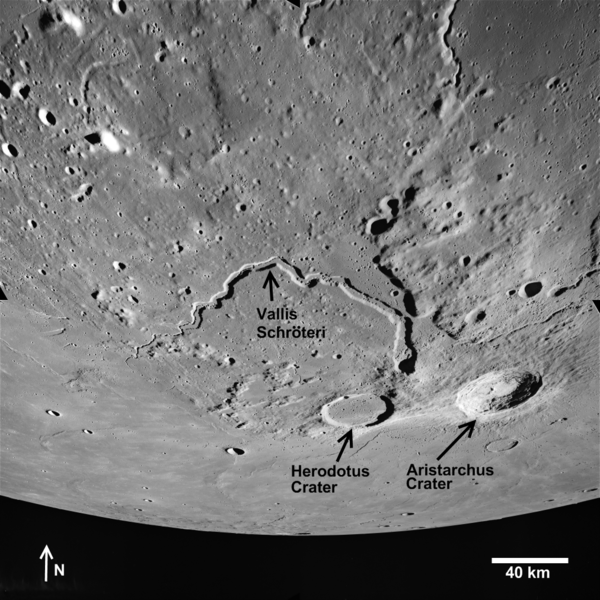
| Project Home | About the Scans | Browse Gallery | Image Map | Support Data | Resources | Ephemeris |
Featured Image - 05/12/2009
The Aristarchus Plateau
The Aristarchus Plateau is one of the most amazing and geologically diverse regions on the Moon (see also here and here). Surrounded by the lavas of Oceanus Procellarum, Aristarchus crater is one of the brightest features on the Moon's surface and is easily seen with a telescope. The Aristarchus region swarms with complex volcanic features, including the Vallis Schröteri, the largest sinuous rille on the Moon (discussed previously as an Apollo Featured Image). The Plateau is also home to one of the largest lunar Regional Dark Mantling Deposits. Large lunar pyroclastic deposits like the Aristarchus Plateau will be intensely studied by the next generation of human lunar explorers because their composition offers important insights into the composition of the lunar interior.
This massive deposit of fine-grained FeO-rich pyroclastic ash is one of the most accessible lunar resource deposits. Future lunar settlers could use this ash for radiation shielding and as feedstock for the production of oxygen and photovoltaic cells. Because of the geologic diversity of this region, the potential for supremely compelling lunar science investigations, and the proximity to rich deposits of readily-accessible resources, the Aristarchus region is a high-priority site for future human lunar exploration and is one of the most frequently-suggested locations for a permanent lunar outpost. The upcoming Lunar Reconnaissance Orbiter Camera is going to collect numerous 0.5 m/pixel images of this region in order to locate prospective landing sites for the future human lunar exploration that will be required to unravel the compelling, complex geology of the Aristarchus region.
Figure 1. Oblique Apollo Metric Mapping Camera photograph looking
south over the Aristarchus Plateau, with major geographic features
highlighted (Apollo Image AS15-M-2611 [NASA/JSC/Arizona State
University]).
References:
Coombs, C. R., Hawke B. R., Allen, C. C. (1998) "Aristarchus Plateau: As a
Potential Lunar Base Site," Proc. Space 98, pp. 608-615
Peterson, C. A., Smith, G. A., and Hawke, B. R. (2005) "The Aristarchus
Plateau: The Next Step in Human Exploration of the Moon",
Lun. Planet. Sci. Conf. XXXVI, Abstract 1673
Ziang J. and Jolliff B. L. (2008) "Aristarchus Region: A Potential
Location for Future Surface Exploration" Proc. Lun. Planet
Sci. Conf. XXXIX, Abstract 2534.

|
|
Space Exploration Resources |
|
 LPI LPI
|
